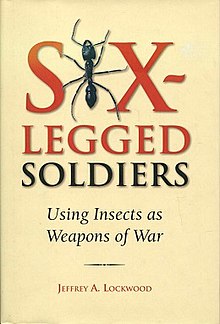Six-legged Soldiers
Six-Legged Soldiers: Using Insects as Weapons of War is a nonfiction scientific warfare book written by award-winning author and University of Wyoming professor, Jeffrey A. Lockwood. Published in 2008 by Oxford University Press, the book explores the history of bioterrorism, entomological warfare, biological warfare, and the prevention of agro-terrorism from the earliest times to modern threats.[2] Lockwood, an entomologist, preceded this book with Ethical issues in biological control (1997) and Locust: The devastating rise and mysterious disappearance of the insect that shaped the American frontier (2004), among others.
 | |
| Author | Jeffrey A. Lockwood |
|---|---|
| Country | USA |
| Language | English |
| Subject | Entomological warfare |
| Genre | Nonfiction |
| Publisher | Oxford University Press |
Publication date | October 10, 2008 |
| Media type | Hardcover |
| Pages | 400 |
| ISBN | 0-19-533305-5 |
| OCLC | 192109802 |
| 358/.3882 22 | |
| LC Class | UG447.8 .L63 2009 |
Summary
Six-Legged Soldiers gives detailed examples of entomological warfare: using buckets of scorpions during a fortress siege, catapulting beehives ("bee bombs") across a castle wall, civilians as human guinea pigs in an effort to weaponize the plague, bombarding civilians from the air with infection-bearing insects, and assassin bugs placed on prisoners to eat away their flesh.[2][3] Lockwood also describes a domestic ecoterrorism example with the 1989 threat to release the medfly (Ceratitis capitata) within California's crop belt.[4] The last chapter highlights western nations' vulnerability to terrorist attacks.[5]
Interviewed about the book by BBC Radio 4's Today programme, the author describes how a terrorist with a suitcase could bring diseases into a country. "I think a small terrorist cell could very easily develop an insect-based weapon."[1]
Criticism
In its January 2009 review, The Sunday Times criticised the book as being "scarcely scholarly" for its mixed collection of myth, legend and historical facts.[2]
References
- Adams, Stephen (5 Jan 2009). "Terrorists could use 'insect-based' biological weapon". telegraph.co.uk. Retrieved 2009-01-05.
- Hastings, Max (January 4, 2009). "Six-legged Soldiers: Using Insects as Weapons of War by Jeffrey A Lockwood". timesonline.co.uk. Retrieved 2009-01-05.
- "Nonfiction Reviews". Six-Legged Soldiers: Using Insects as Weapons of War Jeffrey A. Lockwood. Oxford Univ., $27.95. Publishers Weekly. August 18, 2008. Archived from the original on January 7, 2009. Retrieved 2009-01-09.
- "Six-Legged Soldiers". oupcanada.com. Retrieved 2009-01-05.
- Linthicum, Kenneth J. (November 5, 2008). "Insects of war, terror and torture". Nature. Nature Publishing Group. 456 (7218): 36–37. doi:10.1038/456036a. ISSN 0028-0836.